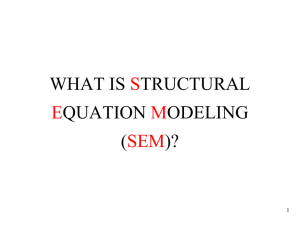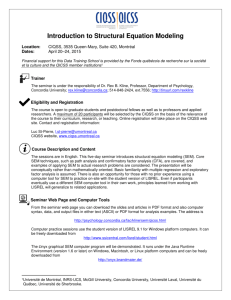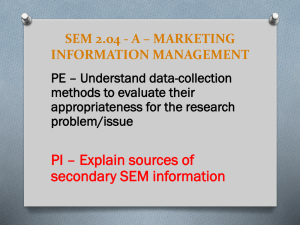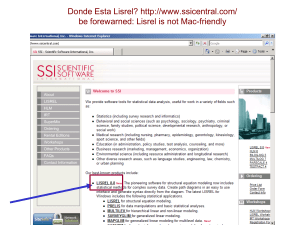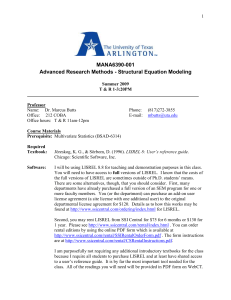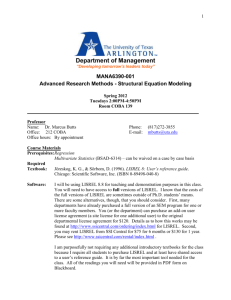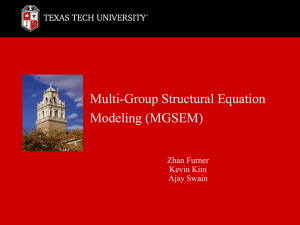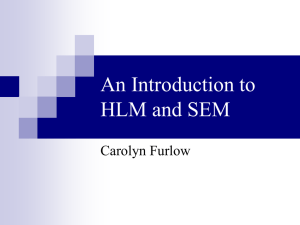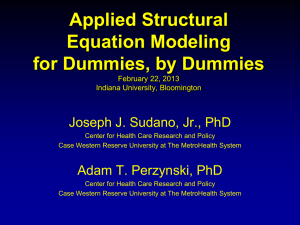INTRODUCTION TO STRUCTURAL EQUATION MODELING
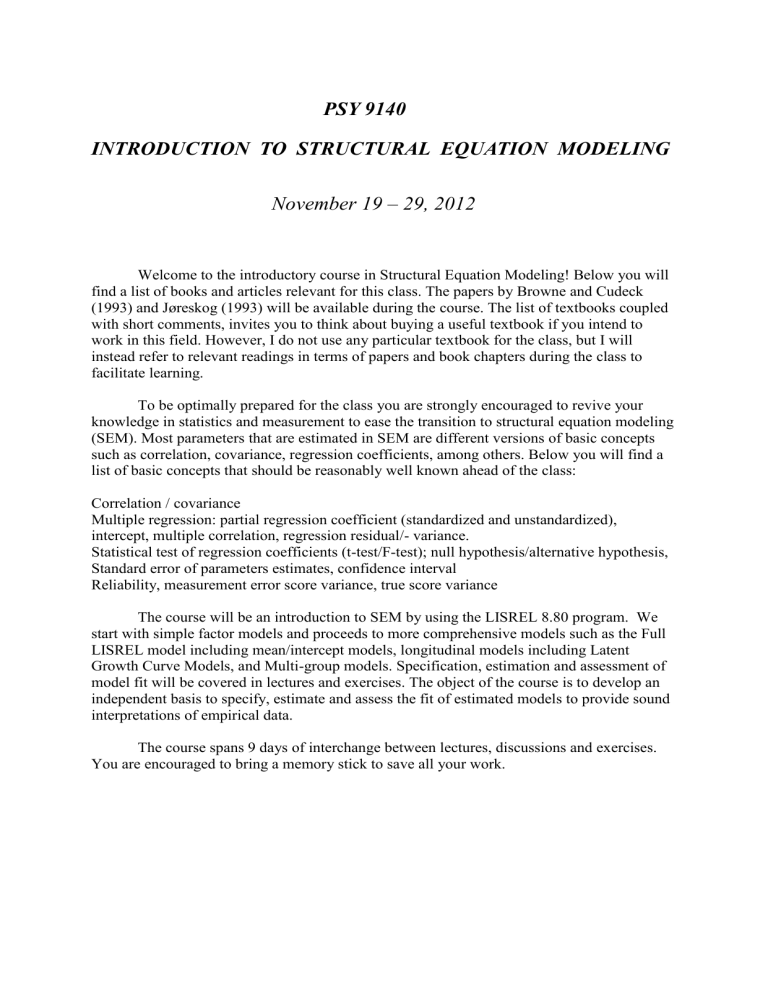
PSY 9140
INTRODUCTION TO STRUCTURAL EQUATION MODELING
November 19 – 29, 2012
Welcome to the introductory course in Structural Equation Modeling! Below you will find a list of books and articles relevant for this class. The papers by Browne and Cudeck
(1993) and Jøreskog (1993) will be available during the course. The list of textbooks coupled with short comments, invites you to think about buying a useful textbook if you intend to work in this field. However, I do not use any particular textbook for the class, but I will instead refer to relevant readings in terms of papers and book chapters during the class to facilitate learning.
To be optimally prepared for the class you are strongly encouraged to revive your knowledge in statistics and measurement to ease the transition to structural equation modeling
(SEM). Most parameters that are estimated in SEM are different versions of basic concepts such as correlation, covariance, regression coefficients, among others. Below you will find a list of basic concepts that should be reasonably well known ahead of the class:
Correlation / covariance
Multiple regression: partial regression coefficient (standardized and unstandardized), intercept, multiple correlation, regression residual/- variance.
Statistical test of regression coefficients (t-test/F-test); null hypothesis/alternative hypothesis,
Standard error of parameters estimates, confidence interval
Reliability, measurement error score variance, true score variance
The course will be an introduction to SEM by using the LISREL 8.80 program. We start with simple factor models and proceeds to more comprehensive models such as the Full
LISREL model including mean/intercept models, longitudinal models including Latent
Growth Curve Models, and Multi-group models. Specification, estimation and assessment of model fit will be covered in lectures and exercises. The object of the course is to develop an independent basis to specify, estimate and assess the fit of estimated models to provide sound interpretations of empirical data.
The course spans 9 days of interchange between lectures, discussions and exercises.
You are encouraged to bring a memory stick to save all your work.
References
Bollen, K. A. (1989). Structural Equations with Latent Variables.
NY: Wiley. [One of the most basic textbooks in the field. Strongly recommended!].
Bollen, K. A. & Curran, P.J. (2006) Latent curve models. A structural equation perspective.
Hoboken, NJ: Wiley. [A thorough introduction to latent growth curve modeling].
Browne, M.W. & Cudeck, R. (1993) Alternative ways of assessing model fit. In K.A.
Bollen and J. Scott Long (Eds.) Testing structural equation models. (pp.136-162). Newbury
Park, CA: Sage.
Byrne, B.M. (1998) Structural Equation Modeling with LISREL, PRELIS and SIMPLIS.
Basic concepts, applications, and programming. Mahwah, N.J.: Erlbaum.
[Recommended as a very helpful text aimed at making you familiar with the LISREL program with respect to concepts, syntax and estimations. The text discusses a large number of applications. It offers a very comprehensive, detailed and instructive introduction for the beginner].
Diamantopoulos, A. & Siguaw, J.W. (2000) Introducing LISREL. A guide for the Uninitiated.
Thousand Oaks, CA: Sage. [A text that gives a “hands on”- introduction to LISREL]
Jøreskog, K.G. (1993) Testing structural equation models. In K.A. Bollen and J. Scott Long
(Eds.) Testing structural equation models. (pp.294-316). Newbury Park, CA: Sage.
Jøreskog, K. & Sørbom, D. (1996). LISREL 8: User`s Reference Guide . Chicago, IL: SSI,
Inc. [This is the LISREL-manual. Recommended! Not a prerequisite to attend the course].
Hagtvet, K.A. (1995) Using preconceptions in quantitative analysis of empirical data. In G.
Imsen, E. Skaalvik & A. Oftedal Telhaug (Eds.) Frontlinjer i pedagogisk forskning.
[Frontlines in educational research]. (pp.27-56). Trondheim, Norway: Norwegian Center for
Child Research/Norwegian Research Council.
Hagtvet, K.A. (2010) Strukturelle likningsmodeller: Målingsmodell og regresjonsmodell. In
Monica Martinussen (Ed.) Kvantitativ forskningsmetodologi i samfunns- og helsefag. Kap. 9.
Pp. 285-314. Bergen, Norway: Fagbokforlaget. [Kort “førsteinnføring” i SEM].
Kaplan, D. (2000) Structural Equation Modeling. Foundations and Extensions.
Thousand Oaks, CA: Sage. [An advanced textbook, but not to the level of Bollen (1989).
Good chapter on multilevel analysis].
Kline, R.B. (2005) Principles and practice of structural equation modeling. (2 nd
.ed.). New
York: The Guilford Press.. [This is a comprehensive text in the sense that it takes you from fundamental concepts in introductory statistics and measurement and all the way into simple and advanced SEM models. Not very technical. Also a recommend text for the beginner who wants to move into the SEM field].
Loehlin, J.C. (1998) Latent variable modeling. (3rd. ed.) Mahwah, N.J.
Erlbaum. [Recommended as an introduction to the SEM field. Not an introduction to any software].
Maruyama, G.M. (1998) Basics of structural equation modeling. Thousand Oaks, CA: Sage
[A very good introduction to the methodology of SEM. Conceptually oriented and not very technical. Provide some LISREL syntaxes. I recommend this book for understanding SEM
Mulaik, S.A. (2009) Linear causal modeling with structural equations. Chapman &
Hall/CRC: New. [One of the most basic textbooks in the field. Strongly recommended!].
Pedhazur, E.J., & Schmelkin, L.P. (1991) Measurement, Design, and Analysis. An Integrated
Approach. Hillsdale, N.J.; Erlbaum. Chapters 23 and 24 offer a brief introduction to
Confirmatory Factor Analysis and Structural Equation Modeling].
Raykov, T. & Marcoulides, G.A. (2000) A first course in structural equation modeling.
Mahwah, NJ: Erlbaum. [Somewhat similar to the book by Byrne (1998) but much less comprehensive. Offer syntax examples for the LISREL and EQS software. It is a good first course in SEM!].
Check : http://www.uio.no/studier/emner/sv/psykologi/PSY9140/h11/ for further information.
If you need more information about the SEM course, please get in touch with me.
See you in November,
Knut A. Hagtvet, PhD
Department of Psychology
P.O.B. 1094, Blindern
N-0317 Oslo
Phone: 228 45201
E-mail: k.a.hagtvet@psykologi.uio.no
D:\....Lisrelkurs\Kursinnhold-H12.doc
